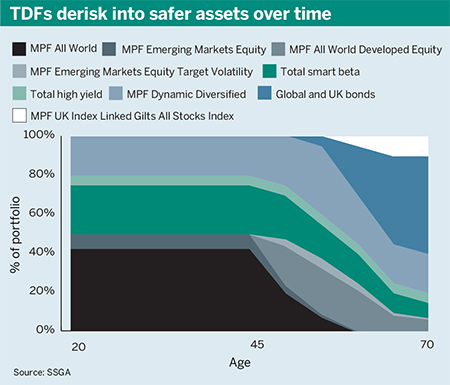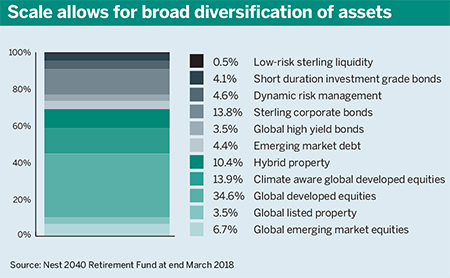Experts have always found it impossible to analyse one without making comparisons with the other. As with footballing greats Lionel Messi and Cristiano Ronaldo, no conversation about the target date fund has ever taken place without mentioning its competitor, the lifestyle fund.
Perhaps this is the best way to frame a discussion on what Ralph Frank, head of defined contribution at Cardano, describes as “two brothers from the same mother”.
TDFs work by rotating from growth assets into safer holdings as investors near retirement. An American invention, they are controlled by an investment manager, who alters the asset allocation until a fixed and prespecified date.
Lifestyle funds have done broadly the same thing for a much longer period in the UK. They follow similar glidepaths to TDFs, but rather than relying on an investment manager, lifestyle funds typically see their asset allocations switch automatically in an approach sometimes derisorily referred to as ‘set and forget’.
You should view TDFs as a box, or a wrapper. What’s important is what goes into the box
Paul Todd, Nest
The current extent of innovation in TDFs is up for debate. The DC space has had to adjust to nearly four years of pension freedoms, and TDFs have had to accommodate freedom and choice for consumers.
Ralph Frank sets the present rate of innovation at “pretty close to zero”. But other experts disagree.
What is the case for TDFs?
The Combined Nuclear Pension Plan added TDFs to its DC scheme at the close of 2016.
The decision to include the structure was made by its investment committee in 2013, on the basis “that a TDF approach would provide increased flexibility for members, diversification, reduced investment risk and simpler and cheaper administration for all the sections”.
The move to BlackRock’s TDF was delayed, following the announcement of pensions freedom and choice in March 2014.
Nigel Aston, senior managing director and head of DC global proposition and strategy at investment manager State Street Global Advisors, recognises two schools of thought on the impact that pension freedoms have had on TDFs in the UK.

What some providers have done in response to freedoms is to offer consumers “three, possibly four, pathways” he says, and “at some point before retirement... try and educate, engage, filter people into a cash and annuity drawdown, a combination default path”, he adds.
Aston advocates a more flexible approach, urging savers to invest in a fund that will allow them to “keep their options open” owing to the unpredictable nature of long-term financial and life planning.
This involves providers having a single range of TDFs, he argues, giving members the flexibility to choose between drawdown, cash, purchasing an annuity or a combination of these options.
“We think that sort of compromise approach to defaults is the one that does the least harm to the most number of people,” he says.
The default pathway solution has champions in other quarters, however. Last month, the Financial Conduct Authority recommended that pension providers be required to develop three readymade investment pathways to make drawdown access easier for confused savers.
Steve Charlton, managing director, DC EMEA and Asia, at SEI, noted a view in the pensions industry that given the long-term presence of lifestyle funds, providers have “got to have a really compelling reason for a target-based date fund to be put in place [instead] of a lifestyle [fund]”.
“I don’t necessarily agree with that view, I think there’s space for both,” he adds.
What’s in the box?
The case in favour of opting for TDFs may depend upon the development of innovative and diversified investment strategies by providers.
Last year, the Telegraph Media Group welcomed SSGA’s decision to add smart beta,
high-yield and emerging market debt across its range of TDFs.
Dipak Wadher, pensions manager at Telegraph Media Group, told Pensions Expert: “We use TDFs as they have the ability to continually evolve and utilise new investment ideas, such as smart beta, as they develop, enabling increased diversification and downside protection at a low cost.”
Paul Todd, director of investment development and delivery at Nest, identified communication with members, efficiency and the “nimble” nature of TDFs as reasons for their adoption.
“It’s helpful to talk to people about what we’re trying to achieve for them for when they retire,” he says, adding that lifestyle funds can often offer complicated guidance for savers when they reach 55.

Consumer understanding and engagement formed a significant part of the FCA’s Retirement Outcomes Review last month, with the regulator recommending the provision of single-page ‘wake-up’ packs when members turn 50.
The TDF structure is “a lot more efficient”, Todd adds. “When you do derisk or uprisk people, if you can do it at the cohort level rather than the individual level, you save an enormous amount of money in terms of things like transaction and trading costs”.
TDFs are also better than lifestyle funds when responding to external events, he says, such as the introduction of freedom and choice.
Todd does not expect the structure of TDFs to change in the near future, arguing that the content of the fund is far more relevant when it comes to examining trends in innovation.
“You should view TDFs as a box, or a wrapper. What’s important is what goes into the box, and what it is you’re trying to achieve with those boxes,” he says.
This includes movement into new asset classes, he argues, adding that Nest is planning investment in private markets.
Can TDFs meet the needs of consumers?
Both TDFs and lifestyle funds typically target a higher level of volatility and return in the growth phase, where savers are a long way from their estimated retirement, before derisking as scheme members approach retirement.
Cardano’s Ralph Frank, who does not recognise much innovation in the space, casts doubt over an approach where providers are “starting out at high risk, where risk is defined typically in terms of volatility of total return of the capital pot, which I think is somewhat meaningless”.
Members are more concerned about the money they receive at the point they need to access it, he adds. “Volatility along the way is noise. The risk to me is how far short of the income that I want am I likely to fall?” he asks.
Research into consumer behaviour would suggest funds need to be designed on the basis that many savers will not know what that desired level of income is, however.
More than a third of people have never estimated their income requirements for later in life, according to provider Aegon. Thirty-eight per cent of individuals are not confident about their ability to retire comfortably.
Jon Parker, director of DC and financial wellbeing consulting at Redington, disagrees with Frank’s view on TDF innovation.
Combined Nuclear picks TDFs for flexibility
The trustees of the industry-wide Combined Nuclear Pension Plan have added TDFs to its DC scheme, having put the move on hold when the pension freedoms were first announced.
“If you look at what the TDFs are actually investing in, I think we’ve seen quite a lot of innovation in the past few years,” he says.
Parker cites Nest’s recent forays into climate-aware equities, hybrid property and its planned movement into private debt infrastructure and venture capital.
“They’re pushing the boat quite far actually,” he adds.














